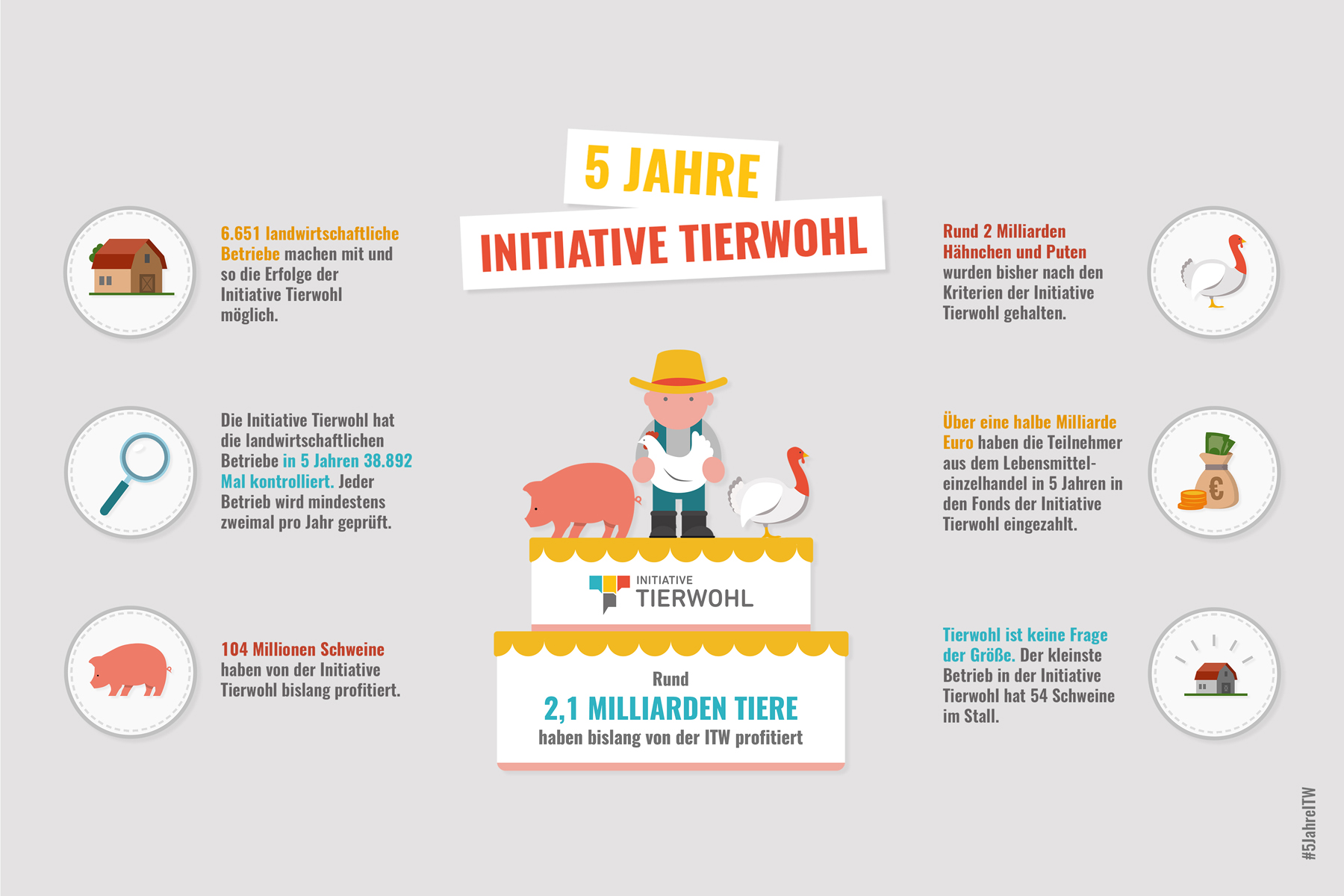

Stakeholders from the agricultural, production and trade sectors got together and resolved to collaborate on a project to improve animal welfare and increase innovation in agriculture exactly five years ago, when the ‘Initiative Tierwohl’, a nationwide animal welfare initiative driven by producers and traders, was born. This presents the ideal opportunity for our very own Animal Welfare Initiative to take stock of what the Initiative Tierwohl has achieved so far.
Pretty much, apparently. According to a recent forsa survey, two thirds of respondents are familiar with the initiative and more than 90% consider it to be a good or very good idea. Moreover, the label has made its way into consumers’ awareness—indeed every third respondent deliberately notices it on the packaging. Today, about 70% of poultry and 25% of all fattening pigs in Germany benefit from the improved standards, including 10% more space and additional manipulable materials. According to the ITW, in excess of 100 million pigs and more than two billion chickens and turkeys have now been bred, raised and slaughtered in accordance with the initiative’s guidelines.
In an interview with German newspaper Die Welt, ITW Managing Director Alexander Hinrichs stressed that every consumer must be able to opt for improved animal welfare when shopping. It is a pity that the food service sector has so far largely held back from commenting on animal welfare and how it’s financed.
The industry initiative’s next round of financing will commence in 2021. However, the financing model is set to change. To date, the major food retailers have paid €130 million a year into a fund that was distributed to participating farmers. This will change as from next year: future financing will be directly from the market. Slaughterhouses would then pay participating pig farmers a fixed premium, which currently amounts to €5.28 per animal. Furthermore, the initiative plans to significantly broaden the scope of the meat labelled with the ITW logo on the refrigerated shelves of supermarkets. This will then be extended to sausages in 2022.
Even though the measures are considered to be minimal in many critics’ opinion, they are an important step towards achieving increased market penetration. And every step that helps to improve overall animal welfare is a step in the right direction. There has to be continuous development, where all parameters are constantly reassessed, when it comes to animal welfare. In fact, many innovative solutions, especially in animal feed, actively promote animal welfare.
Click here to learn more about what feeding can achieve.

Last year, QS Qualität und Sicherheit GmbH (QS) introduced the animal health index for pigs. The partial indices have now been compiled for the second time. How does this help animal welfare?
The animal health index is mandatory for all pig farms affiliated with the QS scheme. It enables breeders to evaluate the findings for the animals they deliver and compare them with those of other farms. The index is intended to help farmers identify and remedy shortcomings in animal welfare at an early stage. So far, the index has had no effect on the price that breeders achieve for their animals.
Results of official ante- and post-mortem inspections are recorded in the abattoir’s IT system for the purpose of the index. QS then evaluates the findings in relation to the abattoir—overarching statewide or nationwide analysis is not yet possible. Indicators that are taken into account are the condition of the respiratory tract, organs and joints, as well as the integrity of the carcase.
Does the index have a future as a tool for improving animal welfare? Leading abattoirs observe that, with this index, QS is merely reproducing what they have long been practicing in their facilities. And the mere collection of data does not constitute a measure that actually improves animal welfare. However, animal welfare is a complex issue that needs to be addressed in a number of manners. Animal production conditions are a major factor, as are animal behaviour, hygiene and feeding. The more farmers know about the condition of their animals, the easier it is for them to introduce and successfully implement measures for improvement. Although the animal health index may well be just one tool among many, it is nevertheless a considerable step in the right direction.

In this video, our colleague Frederic Ferber introduces his work as well as Dr. Eckel’s animal welfare initiative. He explains why animal welfare is no first world problem and how feed additives can make an essential contribution to improving animal welfare.